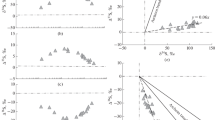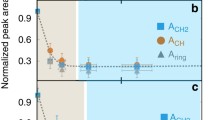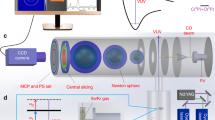Abstract–This paper presents the results of experimental studies of the behavior of mass-independent isotope effects of sulfur Δ33S and Δ36S during photochemical processes initiated by a broadband ultraviolet radiation. Experiments were performed in a flow photochemical reactor using a high-pressure mercury lamp, which is a source of radiation of a wide range with maximum radiation intensity in the wavelength range of 270−330 nm and weaker intensity in the range of 190−250 nm. The temperature and SO2 pressure dependences of the sulfur isotope ratios in the elemental sulfur products are revealed. Based on a comparative analysis of our isotope data with data from previous experimental studies with xenon and hydrogen lamps, it was shown that the correlation between the values of δ34S, Δ33S and Δ36S in elemental sulfur depends on the relative spectral distribution of the radiation intensity. Based on a comparison of our isotope data with data from previous experimental studies with xenon and hydrogen lamps, it was shown that the correlation between the values of δ34S, Δ33S and Δ36S in elemental sulfur depends on the relative spectral distribution of the radiation intensity. Our experiments suggest that photochemical processes in the range of 250−330 nm could play a significant role in the production of an isotope sulfur anomaly in the Archean atmosphere. The conditions in which 250− 330 nm radiation prevails over the 190−220 nm radiation are consistent with the assumption that the level of solar radiation reaching the Earth’s surface in Archean was several orders of magnitude higher in the wavelength range 200−300 nm compared with the current level of radiation in this range.







Similar content being viewed by others
REFERENCES
I. Cnossen, J. Sanz-Forcada, F. Favata, O. Witasse, T. Zegers, and N. F. Arnold, “Habitat of early life: Solar X-ray and UV radiation at Earth’s surface 4–3.5 billion years ago,” J. Geophys. Res. 112 (E2), E02008 (2007).
Y. Endo, Y. Ueno, S. Aoyama, and S. O. Danielache, “Sulfur isotope fractionation by broadband UV radiation to optically thin SO2 under reducing atmosphere,” Earth Planet. Sci. Lett. 453, 9–22 (2016).
J. Farquhar, H. Bao, and M. H. Thiemens, “Atmospheric influence of Earth’s earliest sulfur cycle,” Science 289 (5480), 756–759 (2000).
J. Farquhar, M. Peters, D. T. Johnston, H. Strauss, A. Masterson, U. Wiechert, and A. J. Kaufman, “Isotopic evidence for Mesoarchaean anoxia and changing atmospheric sulphur chemistry,” Nature 449 (7163), 706–709 (2007).
J. Farquhar, J. Savarino, S. Airieau, and M. H. Thiemens, “Observation of wavelength–sensitive mass–independent sulfur isotope effects during SO2 photolysis: Implications for the early atmosphere,” J. Geophys. Res. 106 (E12), 32829–32839 (2001).
A. Galić, P. R. D. Mason, J. M. Mogollón, M. Wolthers, P. Z. Vroon, and M. J. Whitehouse, “Pyrite in a sulfate–poor Paleoarchean basin was derived predominantly from elemental sulfur: Evidence from 3.2 Ga sediments in the Barberton Greenstone Belt, Kaapvaal Craton,” Chem. Geol. 449, 135–146 (2017).
E. M. Galimov, “Role of low solar luminosity in the history of the biosphere,” Geochem. Int. 55 (5), 401–417 (2017).
I. Halevy, D. T. Johnston, and D. P. Schrag, “Explaining the structure of the Archean mass–independent sulfur isotope record,” Science 329 (5988), 204–207 (2010).
E. H. Hauri, D. Papineau, J. Wang, and F. Hillion, “High–precision analysis of multiple sulfur isotopes using NanoSIMS,” Chem. Geol. 420, 148–161 (2016).
A. V. Ignatiev, T. A. Velivetskaya, S. Y. Budnitskiy, V. V. Yakovenko, S. V. Vysotskiy, and V. I. Levitskii, “Precision analysis of multisulfur isotopes in sulfides by femtosecond laser ablation GC–IRMS at high spatial resolution,” Chem. Geol. 493, 316–326 (2018).
D. T. Johnston, “Multiple sulfur isotopes and the evolution of Earth’s surface sulfur cycle,” Earth Sci Rev. 106 (1–2), 161–183 (2011).
A. J. Kaufman, D. T. Johnston, J. Farquhar, A. L. Masterson, T. W. Lyons, S. Bates, A. D. Anbar, G. L. Arnold, J. Garvin, and R. Buick, “Late Archean biospheric oxygenation and atmospheric evolution,” Science 317 (5846), 1900–1903 (2007).
H. Keller-Rudek, G. K. Moortgat, R. Sander, and R. Sörensen “The MPI-Mainz UV/VIS spectral atlas of gaseous molecules of atmospheric interest,” Earth Syst. Sci. Data 5, 365–373 (2013).
A. L. Masterson, J. Farquhar, and B. A. Wing, “Sulfur mass-independent fractionation patterns in the broadband UV photolysis of sulfur dioxide: pressure and third body effects,” Earth Planet. Sci. Lett. 306 (3–4), 253–260 (2011).
S. Ono, “Photochemistry of sulfur dioxide and the origin of mass–independent isotope fractionation in Earth’s atmosphere,” Annu. Rev. Earth Planet. Sci. 45 (1), 301–329 (2017).
S. Ono, N. Beukes, and D. Rumble, “Origin of two distinct multiple-sulfur isotope compositions of pyrite in the 2.5 Ga Klein Naute Formation, Griqualand West Basin, South Africa,” Precambrian Res. 169 (1–4), 48–57 (2009).
S. Ono, A. R. Whitehill, and J. R. Lyons, “Contribution of isotopologue self–shielding to sulfur mass–independent fractionation during sulfur dioxide photolysis,” J. Geophys. Res. Atmos. 118 (5), 2444–2454 (2013).
A. Pavlov and J. Kasting, “Mas–independent fractionation of sulfur isotopes in Archaean sediments: Strong evidence for an anoxic Archaean atmosphere,” Astrobiology 2 (1), 27–41 (2002).
P. Philippot, M. van Zuilen, and C. Rollion-Bard, “Variations in atmospheric sulphur chemistry on early Earth linked to volcanic activity,” Nat. Geosci. 5 (9), 668–674 (2012).
D. L. Roerdink, P. R. D. Mason, M. J. Whitehouse, and T. Reimer, “High-resolution quadruple sulfur isotope analyses of 3.2 Ga pyrite from the Barberton Greenstone Belt in South Africa reveal distinct environmental controls on sulfide isotopic arrays,” Geochim. Cosmochim. Acta 117, 203–215 (2013).
E. Thomassot, J. O’Neil, D. Francis, P. Cartigny, and B. A. Wing, “Atmospheric record in the Hadean Eon from multiple sulfur isotope measurements in Nuvvuagittuq Greenstone Belt (Nunavik, Quebec),” Proc. Natl. Acad. Sci. USA. 112 (3), 707–712 (2015).
Y. Ueno, S. Ono, D. Rumble, and S. Maruyama, “Quadruple sulfur isotope analysis of ca. 3.5 Ga Dresser Formation: new evidence for microbial sulfate reduction in the early Archean,” Geochim. Cosmochim. Acta 72 (23), 5675–5691 (2008).
V. I. Ustinov, V. A. Grinenko, and S. G. Ivanov, “Sulfur isotope effect during SO2 photolysis,” Izv. Akad. Nauk SSSR, Ser. Khim., No. 5, 1192–1193 (1988).
M. J. Whitehouse, B. S. Kamber, C. M. Fedo, and A. Lepland, “Integrated Pb- and S-isotope investigation of sulphide minerals from the early Archaean of southwest Greenland,” Chem. Geol. 222 (1–2), 112–131 (2005).
A. R. Whitehill, B. Jiang, H. Guo, and S. Ono, “SO2 photolysis as a source for sulfur mass–independent isotope signatures in stratospehric aerosols,” Atmos. Chem. Phys. 15, 1843–1864 (2015).
A. R. Whitehill and S. Ono, “Excitation band dependence of sulfur isotope mass–independent fractionation during photochemistry of sulfur dioxide using broadband light sources,” Geochim. Cosmochim. Acta 94, 238–253 (2012).
A. L. Zerkle, M. W. Claire, S. D. Domagal-Goldman, J. Farquhar, and S. W. Poulton, “A bistable organic–rich atmosphere on the Neoarchaean Earth,” Nat. Geosci. 5 (5), 359–363 (2012).
Author information
Authors and Affiliations
Corresponding authors
Additional information
Translated by M. Bogina
Rights and permissions
About this article
Cite this article
Ignatiev, A.V., Velivetskaya, T.A. & Yakovenko, V.V. Effect of Mass-Independent Isotope Fractionation of Sulfur (Δ33S and Δ36S) during SO2 Photolysis in Experiments with a Broadband Light Source. Geochem. Int. 57, 751–760 (2019). https://doi.org/10.1134/S0016702919070061
Received:
Revised:
Accepted:
Published:
Issue Date:
DOI: https://doi.org/10.1134/S0016702919070061




